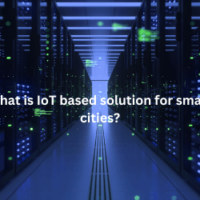
IoT डेटा: स्मार्ट सिटी उदाहरण के लिए आधार
परिचय:
आज के तकनीकी युग में, आईओटी (IoT) ने एक नया दृष्टिकोण प्रदान किया है और स्मार्ट सिटी उदाहरणों के लिए एक महत्वपूर्ण आधार बनाया है। आईओटी डेटा ने नगरीय विकास में नई संभावनाएं खोली हैं, जिससे स्मार्ट सिटी की अद्भुतता और सुगमता में सुधार हो रही है। इस लेख में, हम जानेंगे कि आईओटी डेटा कैसे स्मार्ट सिटी उपयोग केस की नींव प्रदान करता है।
आईओटी डेटा का महत्व:
- संगठन की विभिन्न स्तरों के साथ संवाद: आईओटी डेटा से जुड़े उपकरण और सेंसर्स नगर में विभिन्न स्तरों पर डेटा को संग्रहित करते हैं, जिससे नगर प्रशासन और नागरिकों के बीच संवाद को बढ़ावा मिलता है।
- ट्रैफिक और परिवहन प्रबंधन: आईओटी डेटा का उपयोग ट्रैफिक और परिवहन प्रबंधन में हो सकता है, जिससे ट्रैफिक नियंत्रित किया जा सकता है और सुरक्षित, तेज, और आसान यात्रा का समर्थन किया जा सकता है।
- ऊर्जा और संसाधन प्रबंधन: आईओटी डेटा से ऊर्जा और संसाधनों का प्रबंधन किया जा सकता है, जिससे नगरों में ऊर्जा बचाई जा सकती है और स्थायी विकास का समर्थन किया जा सकता है।
- आपातकालीन प्रबंधन: सेंसर्स और आईओटी डेटा से जुड़े सिस्टम आपातकालीन परिस्थितियों का प्रबंधन करने में मदद कर सकते हैं, जैसे कि प्राकृतिक आपदाएं और आपातकालीन स्थितियों में त्वरित प्रतिक्रिया।
- स्वच्छता और उपायुक्तता: आईओटी डेटा से नगर में स्वच्छता और उपायुक्तता को संरचित रूप से प्रबंधित किया जा सकता है, जिससे नगरों को सुरक्षित और हितकर स्थान बनाए रखा जा सकता है।
समाप्ति:
आईओटी डेटा स्मार्ट सिटी उदाहरणों के लिए एक महत्वपूर्ण आधार प्रदान करता है जो नगरों को सुरक्षित, सुस्त, और अधिक सांगठित बनाता है। यह उपकरणों, सेंसर्स, और डेटा एकत्र करके नगरों को एक नए और उन्नत स्तर पर ले जा रहा है, जिससे नगरीय जीवन को बेहतर बनाने में मदद मिल रही है।
आईओटी का उपयोग: स्मार्ट सिटी में उदाहरण
प्रस्तावना:
स्मार्ट सिटी का अर्थ है एक ऐसा नगर जो नवीनतम तकनीकी उपकरणों और इंटरनेट के साथ जुड़ा हुआ होता है ताकि नगर का प्रबंधन और नागरिकों का जीवन और भी सुगम हो सके। इसमें आईओटी (IoT) का उपयोग विशेषकर सुरक्षित और सांगठित नगरीय जीवन को प्रबंधित करने के लिए किया जाता है। यहां हम जानेंगे कि स्मार्ट सिटी में आईओटी का उपयोग कैसे हो सकता है।
आईओटी के उपयोग के क्षेत्र:
- ऊर्जा प्रबंधन: आईओटी से जुड़े सेंसर्स और उपकरण ऊर्जा की खपत को मापते हैं और सुरक्षित तरीके से ऊर्जा प्रबंधित करने में मदद करते हैं। इससे ऊर्जा की बचत होती है और नगर को स्थायीता की दिशा में मदद मिलती है।
- परिवहन सुविधाएं: आईओटी से जुड़े सेंसर्स और उपकरण नगरीय क्षेत्रों में ट्रैफिक, पार्किंग, और पब्लिक ट्रांसपोर्ट को सुरक्षित और स्मार्ट बनाने में मदद कर सकते हैं।
- सुरक्षा और न्याय: आईओटी से जुड़े कैमरे, सेंसर्स, और अन्य उपकरण स्मार्ट सिटी में सुरक्षा और न्याय की दिशा में मदद कर सकते हैं, जिससे नगर को सुरक्षित बनाया जा सकता है।
- स्वच्छता और प्रबंधन: सेंसर्स और आईओटी स्मार्ट बिन, स्वच्छता कर्मी, और अन्य स्थानों को संग्रहित करने में मदद कर सकते हैं, जिससे स्वच्छता और सार्वजनिक स्थानों का अच्छा प्रबंधन हो सकता है।
- आपातकालीन प्रबंधन: आईओटी से जुड़े सेंसर्स और सिस्टम आपातकालीन परिस्थितियों का त्वरित प्रतिसाद देने में मदद कर सकते हैं, जैसे कि प्राकृतिक आपदाएं या अन्य आपतकालीन स्थितियाँ।
- नागरिक सेवाएं और सुविधाएं: आईओटी से जुड़े अनुकूलन उपकरण नागरिक सेवाओं और सुविधाओं को सुरक्षित, स्मार्ट, और अधिक प्रभावी बना सकते हैं, जिससे नागरिकों को बेहतर सेवाएं मिलती हैं।
सारांश:
आईओटी का उपयोग स्मार्ट सिटी में विभिन्न क्षेत्रों में सुधार करने के लिए किया जा सकता है, जिससे नगर नवीनतम तकनीकी उपकरणों का अच्छा उपयोग करके सुरक्षित, सुस्त, और सुविधाजनक बन सकता है।
स्मार्ट सिटी के लिए आईओटी आधारित समाधान:
परिचय:
स्मार्ट सिटी एक ऐसी तकनीकी प्रणाली है जो नगरीय जीवन को बेहतर बनाने के लिए तकनीकी समाधान प्रदान करती है। इसमें आईओटी (IoT) एक महत्वपूर्ण भूमिका निभाता है, जिससे नगरीय सुविधाओं, सुरक्षा, परिवहन, ऊर्जा प्रबंधन, और अन्य क्षेत्रों में सुधार हो सकता है। यहां हम जानेंगे कि आईओटी के कैसे समाधान स्मार्ट सिटी को बनाने में मदद कर सकते हैं।
आईओटी आधारित समाधान:
- स्मार्ट इंफ्रास्ट्रक्चर: आईओटी सेंसर्स का उपयोग सुरक्षित और स्मार्ट इंफ्रास्ट्रक्चर की बनाए रखने में हो सकता है। सड़कों, पुलों, और इन्फ्रास्ट्रक्चर को नजरअंदाज करने में सहायक हो सकता है और उन्हें सुरक्षित बना सकता है।
- ऊर्जा प्रबंधन: आईओटी से जुड़े सेंसर्स और स्मार्ट ऊर्जा मीटर्स से ऊर्जा की खपत को नियंत्रित करने में मदद कर सकते हैं, जिससे ऊर्जा बचत हो और नगर को स्थायी ऊर्जा सूत्रों की दिशा में मदद मिलती है।
- ट्रैफिक और परिवहन प्रबंधन: स्मार्ट सिटी में आईओटी से जुड़े सेंसर्स और उपकरण ट्रैफिक निगरानी और परिवहन प्रबंधन को सुधारने में मदद कर सकते हैं, जिससे यातायात को सुरक्षित और दक्ष बनाया जा सकता है।
- स्वच्छता और प्रबंधन: आईओटी से जुड़े सेंसर्स स्वच्छता सेवाएं और नगर में उपायुक्तता को सुनिश्चित करने में मदद कर सकते हैं, जिससे स्वच्छ और हितकर नगर बना रखा जा सकता है।
- आपातकालीन प्रबंधन: आईओटी से जुड़े सेंसर्स और सिस्टम आपातकालीन परिस्थितियों का त्वरित प्रतिसाद देने में मदद कर सकते हैं, जैसे कि प्राकृतिक आपदाएं या अन्य आपातकालीन स्थितियाँ।
- सुरक्षा और न्याय: स्मार्ट सिटी में आईओटी द्वारा सुरक्षा सिस्टम्स को संग्रहित करना और नगर में न्याय सुनिश्चित करना एक महत्वपूर्ण क्षेत्र है। यह जनसंख्या की सुरक्षा को बढ़ावा देने में मदद कर सकता है।
समाप्ति:
आईओटी स्मार्ट सिटी के लिए एक सुगम और उपयोगी समाधान प्रदान करता है, जिससे नगरीय इंफ्रास्ट्रक्चर को सुरक्षित, सुस्त, और स्मार्ट बनाए रखा जा सकता है। इससे नागरिकों को बेहतर सुविधाएं मिलती हैं और नगर में सुस्त विकास होता है।




